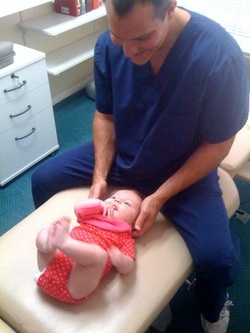Children Need Chiropractic Too
Peter Fysh, DC

A Parent's Guide to Chiropractic Care for Children
Considerable media coverage has been provided in the past year or two for the chiropractic treatment of spinal problems in children. This coverage has frequently attempted to dramatize chiropractic spinal adjusting for children as being unsafe and unnecessary. Reported cases have bordered on the sensational, with untrue "facts" and impressions frequently being conveyed in an apparent endeavor to boost program ratings. Media coverage of the availability of spinal care for children, rather than dissuading parents from bringing their children to chiropractors, in many cases, has actually resulted in more parents seeking chiropractic care for their children.
This article attempts to answer the questions asked by many parents about their children's spinal health. Just as many concerned parents take their children to the dentist for regular check-ups, so it is that many parents who are already chiropractic patients themselves are bringing their children to chiropractors to have their spinal development checked.
The first question relates to the need for children to have regular spinal checks. Frequently parents may ask, "What could my children have wrong with them that they would need to see a chiropractor?" The answer to that question is the trauma of a child's daily life. The spine consists of 26 vertebral segments which can be jammed or misaligned causing minor spinal problems called spinal subluxations.
How Can a Young Infant's Spine Be Traumatized?
A young spine, with few exceptions, usually develops perfectly by the end of pregnancy. It's what happens around the time of birth and in the months thereafter which can sometimes upset the normal functioning of the spine. Spinal segments can be pushed out of place or jammed by the position of the baby in the womb, or can suffer similar problems during labor from the trauma of the trip through the birth canal, or from the birthing process itself. Medical research has identified the fact that many problems early in a child's life can come from birth trauma (See "'KISS' Syndrome" in Dynamic Chiropractic, 6/3/94).
Spinal problems can also occur as a result of the frequent falls suffered by young infants in the first months of life. A fall from a bed, a sudden stop in an automobile, or any significant unsupported movement of the head and neck in an infant can induce excessive movement in the spine causing vertebral subluxations. At the other end of the spine, the act of learning to walk, and the number of simple falls encountered in this way, can induce trauma to the lower spinal segments and to the large sacroiliac joints of the pelvis. Young children learning to walk also fall and hit their heads. These apparently innocent, frequently occurring events can also create spinal subluxations.
How Can Parents Recognize Childhood Spinal Problems?
Unless a child has an obvious problem, it can be difficult for parents to recognize when a child has spinal subluxations. It is not always easy for someone other than a chiropractor, highly trained in evaluating the spine, to determine if the child has a problem, just as it is difficult for someone other than a dentist to determine if a child has any cavities. Both cases take the skills of a trained specialist to perform a thorough evaluation.
There are some signs however which parents may look for which can be an indicator of a child with a spinal problem. Common indicators of spinal problems may include the child's head consistently being tilted to one side; restricted head or neck motion to one side; disturbed sleeping patterns where the child sleeps for only an hour or two at a time; feeding difficulties in the very young infant; the infant may have difficulty nursing at the breast on one particular side.
Common childhood disorders can also sometimes indicate a spinal problem. Persistent earaches, sore throats, colic, headaches, bed-wetting, and growing pains are but some of the more common problems for which parents bring their children to the chiropractor.
Can My Child's Pediatrician Find and Treat These Problems?
This is a reasonable question for parents to ask, since the community generally considers the medical profession to have all the answers to every medical problem. Unfortunately, when it comes to subtle spinal problems, your child's pediatrician is not a trained specialist. The medical profession does have doctors who specialize in spinal problems, known as orthopedic surgeons, but these doctors generally work on the more serious spinal conditions. Few medical doctors, be they orthopedic specialists or pediatricians, are trained to recognize the subtle spinal problems which can cause the conditions listed above.
Take the example of Tiffany, the daughter of Donald Trump and Marla Maples, who was being treated by a chiropractor for colic. Several well respected medical professors from UCLA were reported in a national tabloid as saying that spinal problems could not have anything to do with colic. This is an example of not being aware of the medical research studies which have clearly identified a definite link between colic and problems in an infant's spine. Because the scientific literature identifying the benefits of spinal manipulation for children's problems is not extensive, it is understandable that medical doctors may not be up-to-date in this specialized area.
How Are Children's Spinal Problems Treated?
The first thing your chiropractor will do is to conduct a careful and thorough evaluation of your child's spine. Most chiropractors are trained to evaluate pediatric spinal problems and will use gentle, specific skills to identify, evaluate, and treat any involved spinal areas.
What Does the Treatment Involve?
Spinal adjustments for infants and young children involve very light finger-tip adjustments to correct malfunctioning spinal structures. A light spinal adjustment, using no more than two pounds of pressure, is usually sufficient to restore mobility to spinal joints which have become locked and are causing interference with the normal function of the nervous system. Most adjustments make a "popping" sound when the spinal joints are moved, however this sound is not always heard when children's spines are adjusted.
Does It Hurt?
Generally, no. However, very young infants sometimes take momentary fright at the sudden movement, and may cry for a few seconds.
How Many Treatments Are Required?
Children's spines are a lot more mobile than those of adults and as a result, usually require only a few adjustments to restore normal function. The actual number of adjustments, however, may vary depending on the length of time that the condition has been present.
What Risks Are Involved in Having My Child's Spine Adjusted?
The risk of a child suffering a permanent injury from a spinal manipulation is extremely rare. Chiropractors have been adjusting children's spines for most of the 100 years since chiropractic was first established, and has an excellent safety record. A check of some of the largest insurance carriers, who provide malpractice insurance coverage for chiropractors in the United States, has identified that despite the recent adverse media coverage, not one claim for injury to a child has been filed in the past five years.
Considerable media coverage has been provided in the past year or two for the chiropractic treatment of spinal problems in children. This coverage has frequently attempted to dramatize chiropractic spinal adjusting for children as being unsafe and unnecessary. Reported cases have bordered on the sensational, with untrue "facts" and impressions frequently being conveyed in an apparent endeavor to boost program ratings. Media coverage of the availability of spinal care for children, rather than dissuading parents from bringing their children to chiropractors, in many cases, has actually resulted in more parents seeking chiropractic care for their children.
This article attempts to answer the questions asked by many parents about their children's spinal health. Just as many concerned parents take their children to the dentist for regular check-ups, so it is that many parents who are already chiropractic patients themselves are bringing their children to chiropractors to have their spinal development checked.
The first question relates to the need for children to have regular spinal checks. Frequently parents may ask, "What could my children have wrong with them that they would need to see a chiropractor?" The answer to that question is the trauma of a child's daily life. The spine consists of 26 vertebral segments which can be jammed or misaligned causing minor spinal problems called spinal subluxations.
How Can a Young Infant's Spine Be Traumatized?
A young spine, with few exceptions, usually develops perfectly by the end of pregnancy. It's what happens around the time of birth and in the months thereafter which can sometimes upset the normal functioning of the spine. Spinal segments can be pushed out of place or jammed by the position of the baby in the womb, or can suffer similar problems during labor from the trauma of the trip through the birth canal, or from the birthing process itself. Medical research has identified the fact that many problems early in a child's life can come from birth trauma (See "'KISS' Syndrome" in Dynamic Chiropractic, 6/3/94).
Spinal problems can also occur as a result of the frequent falls suffered by young infants in the first months of life. A fall from a bed, a sudden stop in an automobile, or any significant unsupported movement of the head and neck in an infant can induce excessive movement in the spine causing vertebral subluxations. At the other end of the spine, the act of learning to walk, and the number of simple falls encountered in this way, can induce trauma to the lower spinal segments and to the large sacroiliac joints of the pelvis. Young children learning to walk also fall and hit their heads. These apparently innocent, frequently occurring events can also create spinal subluxations.
How Can Parents Recognize Childhood Spinal Problems?
Unless a child has an obvious problem, it can be difficult for parents to recognize when a child has spinal subluxations. It is not always easy for someone other than a chiropractor, highly trained in evaluating the spine, to determine if the child has a problem, just as it is difficult for someone other than a dentist to determine if a child has any cavities. Both cases take the skills of a trained specialist to perform a thorough evaluation.
There are some signs however which parents may look for which can be an indicator of a child with a spinal problem. Common indicators of spinal problems may include the child's head consistently being tilted to one side; restricted head or neck motion to one side; disturbed sleeping patterns where the child sleeps for only an hour or two at a time; feeding difficulties in the very young infant; the infant may have difficulty nursing at the breast on one particular side.
Common childhood disorders can also sometimes indicate a spinal problem. Persistent earaches, sore throats, colic, headaches, bed-wetting, and growing pains are but some of the more common problems for which parents bring their children to the chiropractor.
Can My Child's Pediatrician Find and Treat These Problems?
This is a reasonable question for parents to ask, since the community generally considers the medical profession to have all the answers to every medical problem. Unfortunately, when it comes to subtle spinal problems, your child's pediatrician is not a trained specialist. The medical profession does have doctors who specialize in spinal problems, known as orthopedic surgeons, but these doctors generally work on the more serious spinal conditions. Few medical doctors, be they orthopedic specialists or pediatricians, are trained to recognize the subtle spinal problems which can cause the conditions listed above.
Take the example of Tiffany, the daughter of Donald Trump and Marla Maples, who was being treated by a chiropractor for colic. Several well respected medical professors from UCLA were reported in a national tabloid as saying that spinal problems could not have anything to do with colic. This is an example of not being aware of the medical research studies which have clearly identified a definite link between colic and problems in an infant's spine. Because the scientific literature identifying the benefits of spinal manipulation for children's problems is not extensive, it is understandable that medical doctors may not be up-to-date in this specialized area.
How Are Children's Spinal Problems Treated?
The first thing your chiropractor will do is to conduct a careful and thorough evaluation of your child's spine. Most chiropractors are trained to evaluate pediatric spinal problems and will use gentle, specific skills to identify, evaluate, and treat any involved spinal areas.
What Does the Treatment Involve?
Spinal adjustments for infants and young children involve very light finger-tip adjustments to correct malfunctioning spinal structures. A light spinal adjustment, using no more than two pounds of pressure, is usually sufficient to restore mobility to spinal joints which have become locked and are causing interference with the normal function of the nervous system. Most adjustments make a "popping" sound when the spinal joints are moved, however this sound is not always heard when children's spines are adjusted.
Does It Hurt?
Generally, no. However, very young infants sometimes take momentary fright at the sudden movement, and may cry for a few seconds.
How Many Treatments Are Required?
Children's spines are a lot more mobile than those of adults and as a result, usually require only a few adjustments to restore normal function. The actual number of adjustments, however, may vary depending on the length of time that the condition has been present.
What Risks Are Involved in Having My Child's Spine Adjusted?
The risk of a child suffering a permanent injury from a spinal manipulation is extremely rare. Chiropractors have been adjusting children's spines for most of the 100 years since chiropractic was first established, and has an excellent safety record. A check of some of the largest insurance carriers, who provide malpractice insurance coverage for chiropractors in the United States, has identified that despite the recent adverse media coverage, not one claim for injury to a child has been filed in the past five years.


